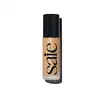What's inside
What's inside
 Key Ingredients
Key Ingredients

 Benefits
Benefits

 Concerns
Concerns

 Ingredients Side-by-side
Ingredients Side-by-side

Water
Skin ConditioningPhenyl Trimethicone
Skin ConditioningButylene Glycol
HumectantDimethicone
EmollientIsononyl Isononanoate
EmollientEthylhexyl Palmitate
EmollientIsododecane
EmollientPropylene Glycol
HumectantCyclomethicone
EmollientTrimethylsiloxysilicate
EmollientPEG-10 Dimethicone
Skin ConditioningPEG/PPG-18/18 Dimethicone
EmulsifyingCetyl PEG/PPG-10/1 Dimethicone
EmulsifyingMagnesium Stearate
Cosmetic ColorantSodium Chloride
MaskingTocopheryl Acetate
AntioxidantSodium Hyaluronate
HumectantDMDM Hydantoin
PreservativeCI 77891
Cosmetic ColorantCI 77491
Cosmetic ColorantCI 77492
Cosmetic ColorantCI 77499
Cosmetic ColorantWater, Phenyl Trimethicone, Butylene Glycol, Dimethicone, Isononyl Isononanoate, Ethylhexyl Palmitate, Isododecane, Propylene Glycol, Cyclomethicone, Trimethylsiloxysilicate, PEG-10 Dimethicone, PEG/PPG-18/18 Dimethicone, Cetyl PEG/PPG-10/1 Dimethicone, Magnesium Stearate, Sodium Chloride, Tocopheryl Acetate, Sodium Hyaluronate, DMDM Hydantoin, CI 77891, CI 77491, CI 77492, CI 77499
Water
Skin ConditioningDicaprylyl Carbonate
EmollientDicaprylyl Ether
EmollientTrioctyldodecyl Citrate
EmollientGlycerin
HumectantPolyglyceryl-6 Polyricinoleate
EmulsifyingPolyglyceryl-6 Polyhydroxystearate
EmulsifyingPolyester-7
Skin ConditioningMica
Cosmetic ColorantNeopentyl Glycol Diheptanoate
EmollientSqualane
EmollientSodium Chloride
MaskingSodium Hyaluronate
HumectantPolyglutamic Acid
Skin ConditioningPhyllanthus Emblica Fruit Extract
HumectantAlthaea Officinalis Root Extract
Skin ConditioningOryza Sativa Bran Extract
Skin ConditioningMagnesium Stearate
Cosmetic ColorantGlyceryl Caprylate
EmollientTrihydroxystearin
Skin ConditioningPolyglycerin-6
HumectantTriethoxycaprylylsilane
Caprylhydroxamic Acid
Stearic Acid
CleansingTocopherol
AntioxidantAscorbyl Palmitate
AntioxidantSodium Benzoate
MaskingPotassium Sorbate
PreservativeIron Oxides
CI 77891
Cosmetic ColorantCI 77492
Cosmetic ColorantCI 77499
Cosmetic ColorantWater, Dicaprylyl Carbonate, Dicaprylyl Ether, Trioctyldodecyl Citrate, Glycerin, Polyglyceryl-6 Polyricinoleate, Polyglyceryl-6 Polyhydroxystearate, Polyester-7, Mica, Neopentyl Glycol Diheptanoate, Squalane, Sodium Chloride, Sodium Hyaluronate, Polyglutamic Acid, Phyllanthus Emblica Fruit Extract, Althaea Officinalis Root Extract, Oryza Sativa Bran Extract, Magnesium Stearate, Glyceryl Caprylate, Trihydroxystearin, Polyglycerin-6, Triethoxycaprylylsilane, Caprylhydroxamic Acid, Stearic Acid, Tocopherol, Ascorbyl Palmitate, Sodium Benzoate, Potassium Sorbate, Iron Oxides, CI 77891, CI 77492, CI 77499
Ingredients Explained
These ingredients are found in both products.
Ingredients higher up in an ingredient list are typically present in a larger amount.
Ci 77492 is also hydrated iron III oxide. It's sole purpose is to give a yellow hue to products.
Iron III oxides are classified as inorganic chemicals for coloring.
Synthetically created Ci 77492 is considered safer than those naturally found. This is because the synthetically created version may contain less impurities. Iron oxides are generally non-toxic and non-allergenic.
Learn more about CI 77492Ci 77499 is also hydrated iron III oxide. It is created from mixing red and black iron oxides. This helps give shades of darkness to a product.
Iron III oxides are classified as inorganic chemicals for coloring.
Ci 77891 is a white pigment from Titanium dioxide. It is naturally found in minerals such as rutile and ilmenite.
It's main function is to add a white color to cosmetics. It can also be mixed with other colors to create different shades.
Ci 77891 is commonly found in sunscreens due to its ability to block UV rays.
Learn more about CI 77891Magnesium Stearate is a salt that is 2 parts stearic acid and 1 part magnesium.
It is a white powder that can be used to add bulk and color to products by binding to oil ingredients.
Chances are, you eat sodium chloride every day. Sodium Chloride is also known as table salt.
This ingredient has many purposes in skincare: thickener, emulsifier, and exfoliator.
You'll most likely find this ingredient in cleansers where it is used to create a gel-like texture. As an emulsifier, it also prevents ingredients from separating.
There is much debate on whether this ingredient is comedogenic. The short answer - comedogenic ratings don't tell the whole story. Learn more about comegodenic ratings here.
The concensus about this ingredient causing acne seems to be divided. Research is needed to understand if this ingredient does cause acne.
Scrubs may use salt as the primary exfoliating ingredient.
Learn more about Sodium ChlorideSodium Hyaluronate is hyaluronic acid's salt form. It is commonly derived from the sodium salt of hyaluronic acid.
Like hyaluronic acid, it is great at holding water and acts as a humectant. This makes it a great skin hydrating ingredient.
Sodium Hyaluronate is naturally occurring in our bodies and is mostly found in eye fluid and joints.
These are some other common types of Hyaluronic Acid:
Learn more about Sodium HyaluronateWater. It's the most common cosmetic ingredient of all. You'll usually see it at the top of ingredient lists, meaning that it makes up the largest part of the product.
So why is it so popular? Water most often acts as a solvent - this means that it helps dissolve other ingredients into the formulation.
You'll also recognize water as that liquid we all need to stay alive. If you see this, drink a glass of water. Stay hydrated!
Learn more about Water